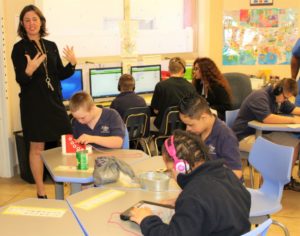Teaching customized to the developmental needs of each child has been the dream of K-12 educators for over a hundred years. When I was in graduate school in the 1970s, we talked continuously about the need to abandon the one-size-fits-all, assembly-line instruction that permeated public education. But we didn’t know how to translate our ivory-tower talk about customization into real-world action.

In the early 1990s, I was a teacher union representative on a statewide commission studying how to improve Florida’s public education system. We proposed reorganizing the system around standards-based, customized instruction, but quickly abandoned the idea after teachers across the state rebelled at a series of public hearings. The teachers said we were naïve and out of touch with classroom realities. While their language may have been a bit harsh, they were correct. Our proposals were impractical. In 1992, public education was still not prepared to meet the unique needs of each child.
Thanks to emerging new technologies and policies, perhaps that time has come. Public education may finally be ready to implement customized instruction in ways that weren’t possible in earlier eras. The inability to scale has historically been the downfall of progressive efforts to move beyond one-size-fits-all instruction. In a country with 56 million PreK-12 students, instructional methods that are highly effective but not scalable have little systemic impact. A good example is Montessori programs. Many students would benefit if they had access to Montessori-based instruction. The first Montessori school opened over 100 years ago and yet, as of 2013, only about 125,000 US public school students were enrolled in Montessori programs.
Effective customized instruction, at scale, is only possible with the assistance of data and technology. When a teacher is tutoring a student, she continually monitors the child’s responses and adjusts her instruction accordingly. Effective one-on-one instruction is a highly interactive, adaptive process. If a child is struggling to comprehend a reading passage, a teacher will redirect the child to a passage that is more appropriate for his reading level. But in a class of fifteen students, teachers are not able to consistently give each child this level of individual attention. Hence, the need for technologies that can help teachers provide one-on-one instruction.
Instructional software today is increasingly intelligent and adaptive. Intelligently adaptive in this context refers to software that is learning about the student as it interacts with her. Unlike first-generation adaptive software that relied on a plethora of if-then statements, newer adaptive software is based on a branch of artificial intelligence called machine learning. Machine learning software uses data analytics to generate probabilities about which responses are most appropriate in a specific instance. Just as a teacher uses her previous experience to predict which instructional approach will be the most effective, software that is intelligently adapting does the same thing. The software analyzes the relevant data in its memory to determine which instructional response has the highest probability of being most effective for a specific student at a given moment. And the software does this in real time, just as a teacher does.
Organizations like Summit Public Schools and AltSchool, a Silicon Valley startup working in a handful of Florida private schools, and, for the first time next school year, a handful of public schools, are working to build technological platforms that track student progress, assess their needs and interests, and build custom “playlists” of instructional activities. The goal of these technological platforms is not to replace human educators. As they become more sophisticated, they can handle more and more of the tasks that have traditionally been foisted upon teachers, freeing the humans to do what they do best.
With instructional software as teaching assistants, teachers will be able to spend less time developing ad-hoc curricula or planning lessons for entire classes and then designing accommodations for students who need additional support, remediation or enrichment. They’ll be able to focus on overseeing learning environments that provide customized instruction to multiple children simultaneously. They will be able to spend more time building relationships with individual students and helping them reach those “ah-ha” moments that often remain beyond technology’s grasp.
The real power of personalization may lie outside the classroom walls. Consider students with special needs, who rely on physical or occupational therapy to succeed in the classroom, or students whose schools abut the St. Lucie Estuary, for whom the best biology classroom may be outdoors and a diving certification may be a vital prerequisite, or low-income students who want to spend their summers cultivating a passion for art or music. In those and countless other cases, parents and educators might want to partner with other providers in their communities to support students’ individual learning processes.
Step Up For Students (SUFS), the nonprofit I help lead, has raised millions of dollars from foundations to develop an online platform capable of efficiently administering hundreds of thousands of Education Savings Accounts (ESAs). ESAs allow parents to pay for customized instruction from a variety of school and community providers, such as libraries, museums, after-school programs, and tutors, giving children access to more diverse learning options.
At SUFS, we know education choice is a necessary but not sufficient condition for achieving excellence and equity in public education. Our goal is for every child to have access to effective, efficient customized instruction in schools, at home and in their communities.
Choice is a pitstop on the road to customization. Charter schools, innovative school district programs, scholarships like the ones we administer at Step Up, digital learning enterprises like Florida Virtual School and programs like dual enrollment are all helping lay the groundwork for an educational system capable of tailoring teaching and learning to the needs of each individual student. It’s been a long journey, but there is a faint light at the end of the tunnel.
Editor’s note: For another, excellent take on educational choice, technology and customization, see this July 16 op-ed in Education Week.


